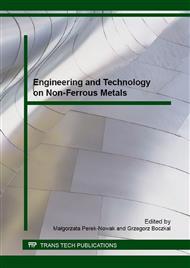[1]
J. Bai, Y. Sun, S. Xun, F. Xue, T. Zhu, Microstructure and tensile creep behavior of Mg–4Al based magnesium alloys with alkaline-earth elements Sr and Ca additions. Mater. Sci. Eng. A419 (2006) 181–188.
DOI: 10.1016/j.msea.2005.12.017
Google Scholar
[2]
E. Aghion, B. Bronfin, F. Von Buch, H. Friedrich, S. Schumann, Newly Developed Magnesium Alloys for Powertrain Applications, JOM 55(11) (2003) 30-33.
DOI: 10.1007/s11837-003-0206-8
Google Scholar
[3]
K. U. Kainer, Magnesium - Alloys and Technologies, Wiley-VCH, (2003).
Google Scholar
[4]
A.A. Luo, Recent magnesium alloy development for elevated temperature applications, Int. Mater. Reviews 49(1) (2003)13-30.
Google Scholar
[5]
H. Friedrich, B.L. Mordike, Magnesium Technology, Metallurgy, Design Data, Applications, Springer-Verlag Berlin Heidelberg (2006).
Google Scholar
[6]
T. Rzychoń., B. Adamczk-Cieślak, A. Kiełbus, J. Mizera, The influence of hot-chamber die casting parameters on the microstructure and mechanical properties of magnesium-aluminum alloys containing alkaline elements, Materialwiss. Werkstofftech. 43(5) (2012).
DOI: 10.1002/mawe.201200976
Google Scholar
[7]
T. Rzychoń, J. Szala, T. Kukiełka, Detection of intermetallic compounds in a Mg-5Al-3Ca-0. 7Sr-0. 2Mn magnesium alloy, Solid State Phenom. 197 (2013) 137-142.
DOI: 10.4028/www.scientific.net/ssp.197.137
Google Scholar
[8]
T. Rzychoń, A. Kiełbus, L. Lityńska-Dobrzyńska, Microstructure, microstructural stability and mechanical properties of sand-cast Mg-4Al-4RE alloy, Mater. Charact. 83 (2013) 21-34.
DOI: 10.1016/j.matchar.2013.06.001
Google Scholar
[9]
T. Rzychoń, A. Kiełbus, Microstructure and tensile properties of sand cast and die cast AE44 Magnesium Alloy, Arch. Metall. Mater. 53 (2008) 901-907.
Google Scholar
[10]
M. Gupta, N.M.L. Sharon, Magnesium, magnesium alloys and magnesium composites, John Wiley & Sons, Inc., Hoboken, New Jersey, (2011).
Google Scholar
[11]
A. Kiełbus, T. Rzychoń, L. Lityńska-Dobrzyńska, G. Dercz, Characterization of β and Mg41Nd5 equilibrium phases in Elektron 21 magnesium alloy after long-term annealing, Solid State Phenom. 163 (2010) 106-109.
DOI: 10.4028/www.scientific.net/ssp.163.106
Google Scholar
[12]
T. Rzychoń, A. Kiełbus, M. Serba, The influence of pouring temperature on the microstructure and fluidity of Elektron 21 and WE54 magnesium alloys, Arch. Metall. Mater. 55 (2010) 7-13.
Google Scholar
[13]
B. Dybowski, A. Kiełbus, R. Jarosz, Effect of mould components on the cooling rate, microstructure, and quality of WE43 magnesium casting alloy, Arch. Metall. Mater. 29 (2014) 1527-15322.
DOI: 10.2478/amm-2014-0258
Google Scholar
[14]
A. Kiełbus, T. Rzychoń, The intermetallic phases in sand casting magnesium alloys for elevated temperature, Mater. Sci. Forum 690 (2011) 214-217.
DOI: 10.4028/www.scientific.net/msf.690.214
Google Scholar
[15]
www. magnesium-elektron. com (DS455. pdf).
Google Scholar
[16]
M. Podosek, G.W. Lorimer, The influence of intergranular microstructure of Mg-Zn-RE alloys on properties at elevated temperatures, Arch. Metall. 45(1) (2000) 47-55.
Google Scholar
[17]
I.P. Moreno, T.K. Nandy, J.W. Jones, J.E. Allison, T.M. Pollock, Microstructural stability and creep pf rare-earth containing magnesium alloys, Scripta Mater. 48 (2003) 1029-1034.
DOI: 10.1016/s1359-6462(02)00595-x
Google Scholar
[18]
T. Rzychoń, Microstructure of MgAl5Ca3Sr alloy after creep deformation and high-temperature heat treatment, Materialwiss. Werkstofftech. 5 (2014) 1-10.
DOI: 10.1002/mawe.201400233
Google Scholar
[19]
A. Suzuki, N.D. Saddock, L. Riester, E. Lara-Curzio, J.W. Jones, T.M. Pollock, Effect of Sr additions on the microstructure and strength of a Mg-Al-Ca ternary alloy, Metallurgical and Materials Transactions A 38A (2007) 420-427.
DOI: 10.1007/s11661-006-9031-3
Google Scholar
[20]
S Roskosz, B Dybowski, R Jarosz, Influence of mould cooling rate on the microstructure of AZ91 magnesium alloy castings, State Phenom. 191 (2012) 115-122.
DOI: 10.4028/www.scientific.net/ssp.191.115
Google Scholar
[21]
S.M. Liang, R.S. Chen, J.J. Blandin, M. Suery, E.H. Han, Thermal analysis and solidification pathways of Mg-Al-Ca system alloys, Mater. Sci. Eng. 480 (2008) 365-372.
DOI: 10.1016/j.msea.2007.07.025
Google Scholar
[22]
N. Zheng, H.Y. Wang, Z.H. Gu, W. Wang, Q.C. Jiang, Development of an effective modifier for hypereutectic Mg–Si alloys, J. Alloys Compd. 463 (2008) L1-L4.
DOI: 10.1016/j.jallcom.2007.08.082
Google Scholar
[23]
F. Mirshahi, M. Meratian, High temperature tensile properties of modified Mg/Mg2Si in situ composite, Mater. Des. 33 (2012) 557–562.
DOI: 10.1016/j.matdes.2011.05.001
Google Scholar
[24]
T. Rzychoń, J. Szala, A. Kiełbus, Microstructure, castability, microstructural stability and mechanical properties of ZRE1 magnesium alloy, Arch. Metall. Mater. 57 (2012) 254-252.
DOI: 10.2478/v10172-012-0018-3
Google Scholar
[25]
T. Rzychoń, Characterization of Mg-rich clusters in the C36 phase of the Mg-5Al-3Ca-0. 7Sr-0. 2Mn alloy, J. Alloys Compd. 598 (2014) 95-105.
DOI: 10.1016/j.jallcom.2014.02.029
Google Scholar
[26]
T. Rzychoń, B. Adamczyk-Cieślak, Microstructure and creep resistance of Mg-Al-Ca-Sr alloys, Arch. Metall. Mater. 59 (2014) 327-332.
DOI: 10.2478/amm-2014-0054
Google Scholar
[27]
T. Rzychoń, Microstructure of hypereutectic Mg-Si alloy with Sn, Al and Mn additions, Solid State Phenom. 229 (2015) 65-70.
DOI: 10.4028/www.scientific.net/ssp.229.65
Google Scholar


